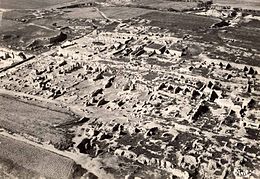- Battle of Carthage (c. 149 BC)
-
Battle of Carthage Part of the Third Punic War 
The ruins of CarthageDate c.149 BC – spring of 146 BC Location Carthage (near modern Tunis) Result Decisive Roman victory;
Marks end of Punic Wars: Destruction of Carthage's city and empire.Belligerents Roman Republic Carthage Commanders and leaders Scipio Aemilianus
Manius ManiliusHasdrubal the Boeotarch Strength 80,000 men and 4,000 cavalry[citation needed] 500,000:
90,000 defenders,
410,000 civilians[citation needed]Casualties and losses 17,000 killed[citation needed] 445,000 killed,
55,000 enslaved[citation needed]- Carthage
 The location of Carthage
The location of Carthage
The Battle of Carthage was the major act of the Third Punic War between the Phoenician city of Carthage in Africa (a suburb of present-day Tunis) and the Roman Republic. It was a siege operation, starting sometime between 149 and 148 BC, and ending in the spring of 146 BC with the sack and complete destruction of the city of Carthage.
After a Roman army under Manius Manilius landed in Africa in 149 BC, Carthage surrendered and handed over hostages and arms. However, the Romans demanded the complete destruction of the city, and surprisingly to the Romans the city refused, the faction advocating submission overturned by one in favor of defense.
The Carthaginians manned the walls and defied the Romans, a situation which lasted for two years due to poor Roman commanders.[citation needed] In this period, the 500,000 Carthaginians inside the wall transformed the town into a huge arsenal. They produced about 300 swords, 500 spears, 140 shields and 1,000 projectiles for catapults daily.[citation needed]
The Romans elected the young but popular Scipio Aemilianus as consul, a special law being passed to lift the age restriction. Scipio restored discipline, defeated the Carthaginians in a field battle, and besieged the city closely, constructing a mole to block the harbor.
In the spring of 146 BC the Romans broke through the city wall but they were hard pressed to take the city. Every building, house and temple had been turned into a stronghold and every Carthaginian had taken up a weapon. The Romans were forced to move slowly, capturing the city house by house, street by street and fighting each Carthaginian soldier who fought with courage born of despair. Eventually after hours upon hours of house-to-house fighting, the Carthaginians surrendered. An estimated 50,000 surviving inhabitants were sold into slavery. The city was then leveled. The land surrounding Carthage was declared ager publicus, and it was shared between local farmers, and Roman and Italian ones.
Before the end of the battle, a dramatic event took place: the few survivors had found refuge in the temple of Eshmun, in the citadel of Byrsa, although it was already burning. They negotiated their surrender, but Scipio Aemilianus expressed that forgiveness was impossible either for Hasdrubal, the general who defended the city, or for the Roman deserters. Hasdrubal then left the Citadel to surrender and pray for mercy (he had tortured Roman prisoners in front of the Roman army). At that moment Hasdrubal's wife allegedly went out with her two children, insulted her husband, sacrificed her sons[citation needed] and jumped with them into a fire that the deserters had started[citation needed]. The deserters then jumped into the fire too[citation needed], and Scipio Aemilianus started crying. He shouted a sentence from Homer, a prophecy about the destruction of Troy, that could be applied now to Carthage's end:
The day shall come when sacred Troy shall fall, and King Priam and all his warrior people with him.
Scipio declared that he feared it could be applied to Rome in the future.[1][2]
After the war, Scipio Aemilianus was given the honorific surname "Africanus" ("The African").
Since the 19th century, various historians have claimed that the Romans plowed over the city and sowed salt into the soil after destroying it, but this is not supported by ancient sources.[3]
References
- ^ Polybius: Histories, Book XXXVIII, 7-8 and 20-22. English translation and comments by W. R. Patton. Loeb classical library, 1927, pp. 402-409 and 434-438.
- ^ http://penelope.uchicago.edu/Thayer/E/Roman/Texts/Polybius/38*.html
- ^ Ridley, R.T. (1986). "To Be Taken with a Pinch of Salt: The Destruction of Carthage". Classical Philology 81 (2). JSTOR 269786.
- Duncan B. Campbell, "Besieged: siege warfare in the ancient world", Osprey Publishing, 2006, ISBN 1846030196, pages 113-114
Punic Wars First Punic War - Messana
- Agrigentum
- Lipari Islands
- Mylae
- Sulci
- Tyndaris
- Cape Ecnomus
- Aspis
- Adys
- Tunis
- Panormus
- Drepana
- 1st Lilybaeum
- Siege of Drepana
- Mount Ercte
- 1st Mt. Eryx
- 2nd Mt. Eryx
- Aegates Islands

Mercenary War - Utica
- Bagradas River
- Carthage
- "The Saw"
- Tunis
Second Punic War - Saguntum
- Lilybaeum
- Rhone
- Ticinus
- Trebia
- Cissa
- Lake Trasimene
- Ebro River
- Ager Falernus
- Geronium
- Cannae
- 1st Nola
- Battle of Dertosa
- 2nd Nola
- Battle of Cornus
- 3rd Nola
- 1st Beneventum
- Syracuse
- 1st Tarentum
- 1st Capua
- 2nd Beneventum
- Silarus
- 1st Herdonia
- Upper Baetis
- 2nd Capua
- 2nd Herdonia
- Numistro
- Asculum
- 2nd Tarentum
- Baecula
- Grumentum
- Metaurus
- New Carthage
- Ilipa
- Crotona
- Utica
- Great Plains
- Cirta
- Po Valley
- Zama
Third Punic War Categories:- 149 BC
- Battles of the Third Punic War
- Sieges involving ancient Rome
- Military history of Tunisia
Wikimedia Foundation. 2010.
